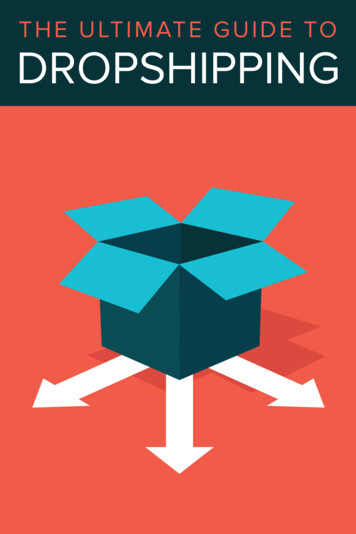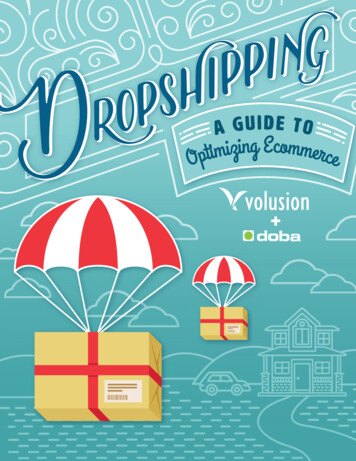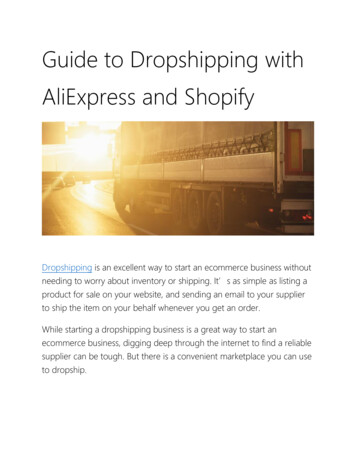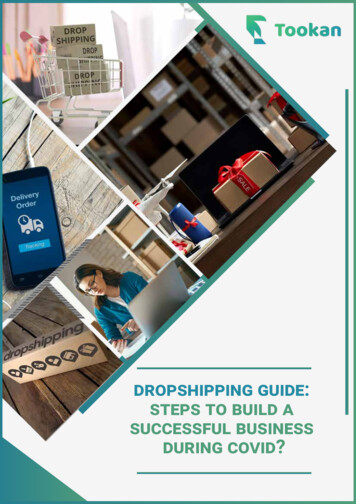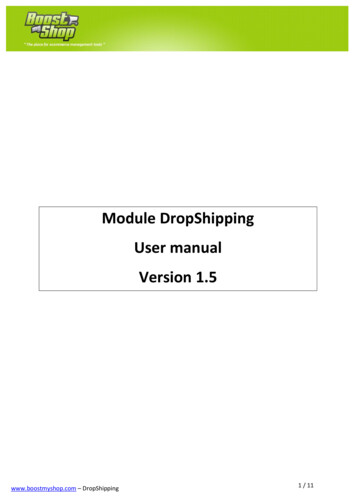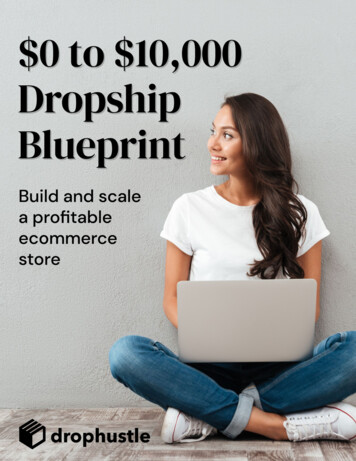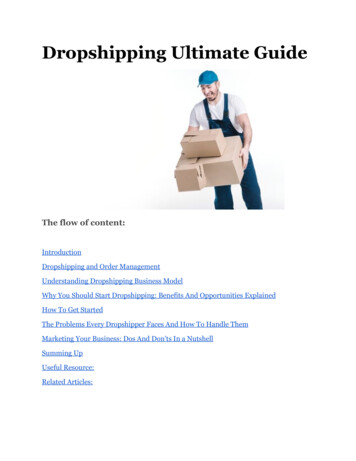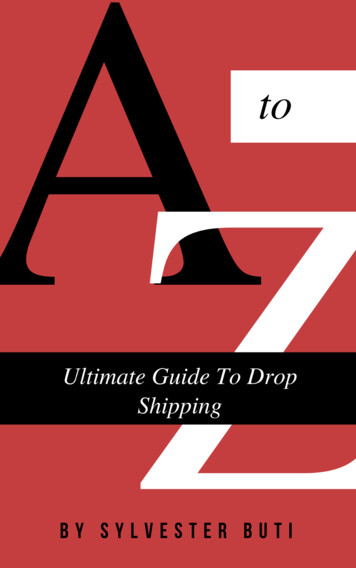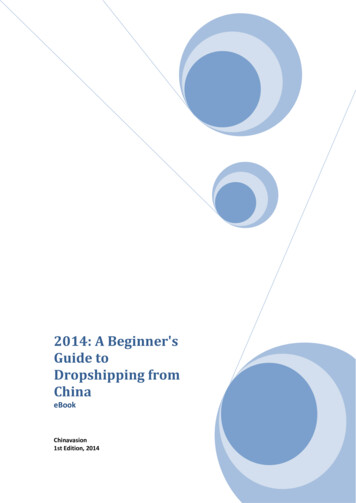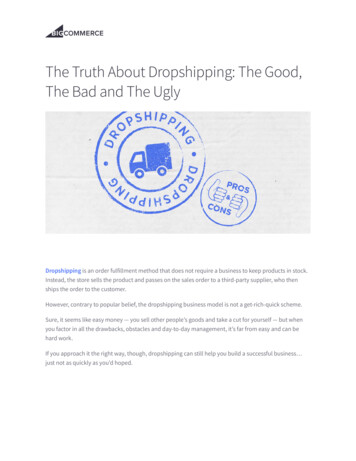
Transcription
The Truth About Dropshipping: The Good,The Bad and The UglyDropshipping is an order fulfillment method that does not require a business to keep products in stock.Instead, the store sells the product and passes on the sales order to a third-party supplier, who thenships the order to the customer.However, contrary to popular belief, the dropshipping business model is not a get-rich-quick scheme.Sure, it seems like easy money — you sell other peopleʼs goods and take a cut for yourself — but whenyou factor in all the drawbacks, obstacles and day-to-day management, itʼs far from easy and can behard work.If you approach it the right way, though, dropshipping can still help you build a successful business just not as quickly as youʼd hoped.
From pros and cons of dropshipping to the right approaches, and from the best dropshippingcompanies to FAQs, hereʼs everything you need to know before you start dropshipping on yourecommerce platform:Growing your high-volume or established business?Start your 15-day free trial, schedule a demo or give us a call at 1-866-581-4549.
5 Hard Truths About DropshippingIf youʼre a business owner looking to ship products for your online store (i.e. a traditional retail businessselling t-shirts) without the hassle of having to stock the inventory yourself — or potentially add newproducts — the dropshipping model can be a solution and, most importantly, be beneficial to anecommerce store.A er a customer orders something online, the dropshipping business then ships the product straight tothe customer. Itʼs a way for large companies and small companies alike to source products while makinga little money and saving some storage space at the same time.This is easier said than done, of course, so before you put all of your savings into a dropshipping store,here are some things you need to know on why it can be di icult:1. Low profit margins.Sure, since you donʼt have to manage or store your own inventory, the overhead is low — but so are thereturns.You put less money in, but you get less money out. That means you have to do a lot of business just tostay afloat, let alone turn a profit, especially considering most of the money goes to the supplier.These low margins are hardly enough to cover your expenses and operating costs formarketing/advertising, maintaining your site, including search engine optimization (SEO), managingsales orders and covering your o ice hours.You can predict your income using these variables (theyʼre averages, so theyʼll change depending onyour industry and situation):20% margin.2% conversion rate.You can then calculate a working estimate using this equation:Growing your high-volume or established business?Start your 15-day free trial, schedule a demo or give us a call at 1-866-581-4549.
(Tra ic x 0.02) x (Avg order value x 0.2) ProfitWhile this is fine for a quick starting estimate, there are a few problems you also have to consider:Your discount on buying from manufacturers and wholesalers could be less than 20%.This doesnʼt account for any of the additional expenses mentioned above that you have to payfrom your end. Itʼs not the final profit.For most products, youʼll have to cut into your profits to keep your sales prices competitive. If youstubbornly hold on to your 20% margin, other companies can undercut you.On top of that, youʼll notice that your profit is also largely determined by your tra ic, so if youʼre buildingan ecommerce brand from scratch on platforms such as BigCommerce and Shopify, youʼll be strugglingfor a long time as you build a client base.Although it seems hands o , dropshippers always have to deal with their wholesale suppliers, orderprocessing, returns, and customer service.Itʼs much more reasonable to approach dropshipping when you already have a regular source of tra ic.2. Highly competitive.There will always be overly optimistic entrepreneurs who focus solely on the “low overhead” part andignore the clear evidence above.Because very little capital is required to start a dropshipping business, that low barrier to entry means alot of fierce competition, with the most popular markets su ering more than others.Basically, the bigger a company is, the more they can reduce their markups to o er the lowest prices.Growing your high-volume or established business?Start your 15-day free trial, schedule a demo or give us a call at 1-866-581-4549.
To make matters worse, chances are you donʼt have an exclusive deal with your suppliers.That means any number of competitors could be selling your exact same products. And if youʼre juststarting out as a small business, your rivals with years of experience have the resources you donʼt toundercut your prices.That means potential customers can buy the exact same thing from someone else for cheaper — whywould they buy from you?3. No control over the supply chain.In standard ecommerce, if customers complain about product quality, fulfillment speed or returnpolicies, you can address the problems yourself.In dropshipping, store owners are more or less at the mercy of the supplier — but youʼre the one whostill has to talk to your customers directly.Dropshippers are essentially trapped, doing little more than hoping the supplier addresses theproblems while simultaneously reassuring the customer about something thatʼs out of their control.On top of that, thereʼs also a delay in communication as the dropshipper goes back-and-forth betweenthe customer and the supplier. If one answers slowly, all communication grinds to a halt and theproblems take longer to fix.And if theyʼre vocal about it, including on social media, those bad reviews early on could end yourbusiness before it even starts.4. Legal liability issues.Although this isnʼt a common problem for dropshippers, itʼs worth mentioning. Some suppliers arenʼt aslegitimate as they claim, and you donʼt always know where the merchandise comes from.Even more deceptive is when suppliers illegally use a trademarked logo or another companyʼsintellectual property, which happens more than average.Growing your high-volume or established business?Start your 15-day free trial, schedule a demo or give us a call at 1-866-581-4549.
This potential problem can be rectified with a solid Dropshipping Agreement Contract, but not everydropshipping upstart knows that.Itʼs something youʼll want to keep in mind when choosing suppliers.5. Di icult to build a brand.Like ghostwriters or behind-the-scenes songwriters, dropshippers must understand that the credit fortheir work goes to someone else.If whatever product youʼre selling is so amazing, your customers are going to focus mostly on theproductʼs brand and forget about the shopping experience entirely.A er all, itʼs not your logo on the box.Again, thatʼs just another reason why dropshipping makes more sense for already-established brandsthan new ones.Growing your high-volume or established business?Start your 15-day free trial, schedule a demo or give us a call at 1-866-581-4549.
The Right Approaches to DropshippingDropshipping makes a better sideshow than the main event. While its faults make it hard to support abusiness on its own, it still o ers enough benefits to help ecommerce companies improve their businesssubstantially.Consider these four approaches to using dropshipping e ectively:1. Market research.Dropshipping works better as a means to an end, not the end itself.Use dropshipping to mitigate the risk in trying out new products and used for market research.Rather than raising your inventory costs by packing your warehouse with an unpredictable product, testit out with a trial period using dropshipping.More than just discovering if it sells or not, youʼll also have a better estimate of how much it sells for,giving you a more accurate number of what quantity to buy for your initial stock.This is doubly important for trying out new product types, which always carry inherent risk.For example, maybe youʼve been quite successful at selling dog products. Would that translate well forcat products, too?That could be hit-or-miss, but you can always test the water by dropshipping a few products and seehow it goes.2. Protection from overselling.Experienced ecommerce brands know that market fluctuations arenʼt always predictable. Rather thanraising inventory costs by overstocking to meet unlikely maximums, having a dropshipping supplier as abackup saves you money without losing those sales.Growing your high-volume or established business?Start your 15-day free trial, schedule a demo or give us a call at 1-866-581-4549.
This is especially useful for seasonal overflow.Itʼs a great safeguard against the uncertainties all retailers face.Having dropshipping options in place also makes great insurance against extreme circumstances.If something like a natural disaster happens to your warehouse space, you can still fulfill pre-madeorders by dropshipping the products from elsewhere.The same holds true for side-stepping surprise shipping delays.3. Strategic shipping systems.One unfortunate consequence of expanding your business is shipping complications. The farther outyou get from your warehouse or fulfillment centers, the more shipping costs and fees youʼll incur.Dropshipping can be the perfect solution for some problematic locations that fall outside your profitableregions.Maybe shipping that far costs too much, or maybe storage prices are too high to justify setting upa new shipping center.Maybe itʼs an issue of taxes or extra fees, like when shipping out of the state or country. Relying ondropshipping for these select areas could be the determining factor in keeping you out of the red.Moreover, just as dropshipping can be useful in market research, you can also use it to test new locales.Why not use dropshipping for a trial period in a new location to see if itʼs worth opening a new facilitythere?4. High-maintenance products.Some products cost more to stock and ship than others.In certain circumstances, it may be more profitable for you to dropship them versus storing themyourself.What do we mean by high-maintenance products?Growing your high-volume or established business?Start your 15-day free trial, schedule a demo or give us a call at 1-866-581-4549.
Any products that necessitate extra fees for storing or shipping, such as:Large products — Some products take up so much space, their sales donʼt make up the costs ofthe excessive storage room.Heavy products — If a productʼs weight makes it cost too much to ship, try dropshipping from amanufacturer or wholesaler.Fragile products — Fragile products require special care when shipping. In these cases, thesupplier or manufacturer might be better equipped to meet these requirements than you.Valuables — High-value items like fine jewelry, antiques, etc., require additional security that notall warehouses can o er. Rather than risking the , you could leave the storage to someone whocan adequately protect them.Special conditions — Maybe you want to sell items that need to be kept frozen, or materialssensitive to light. If your inventory needs special conditions, you may be better o dropshippingthan storing it yourself.Unless your entire company specializes in these types of products, it doesnʼt make sense to payadditional storage and shipping fees for a small subsection of your business.But you can still keep your customers happy by o ering these products through dropshipping.Ready to launch your dropshipping business?BigCommerce makes designing the store of your dreams and discovering popular dropshippingproducts easy. Start with your 14-day free trial.Learn moreGrowing your high-volume or established business?Start your 15-day free trial, schedule a demo or give us a call at 1-866-581-4549.
How to Choose the Best Dropshipping SuppliersWhenever you include dropshipping into your sales strategy — in any capacity — you are entering abusiness partnership with the supplier.Like we said above, as the vendor you are o en at the mercy of your dropshipper for product quality,timely shipping, and even legal compliance.That means you must choose them with the utmost care.For one thing, you want to make sure that the products are as advertised, but you should also see if theirshipping meets your criteria.Outside of the condition of the products, thereʼs still plenty of concerns about how your supplierconducts business.Hereʼs a quick-reference checklist of questions to ask yourself before signing on to do business withsomeone:How do they handle returns or damaged products?How long does it take them to fulfill an order, from sale to delivery?How is their customer support? (Feel free to test this yourself.)Do they insure orders?Do they o er fraud protection?Can you find reviews or references online?Also donʼt forget the Dropshipping Agreement Contract, explained above.To help quicken your research time, weʼve previously compiled a list of the best dropshippingcompanies, including Spocket and AliExpress Dropshipping.Growing your high-volume or established business?Start your 15-day free trial, schedule a demo or give us a call at 1-866-581-4549.
Dropshipping for Beginners: FAQsHere are some simple answers to frequently asked questions about dropshipping:What is dropshipping and how does it work?Dropshipping is when a vendor fulfills orders from a third party and has them ship products directly tothe customer.In other words, the vendor passes on the sales order to the supplier, who then fulfills the order.The vendor usually pays for the item at a discount by working directly with a manufacturer orwholesaler; their profit comes from the di erence in the initial item cost and whatever price they sell itat.The vendor does not store their own inventory or ship items directly. Instead, they focus mostly onmarketing, advertising, and managing their online presence.How do I incorporate dropshipping into my business?Dropshipping can be a complement to a traditional ecommerce business model.Assuming you already have an online presence in one or more stores (or at least know how to set thatup), incorporating dropshipping is similar to launching any other new product, with a few distinctions.Hereʼs a quick step-by-step guide:1. Research what products would fit well with your strategy, market, and customer base.2. Research how your competitors are selling the product, namely pricing.3. Find the best supplier (see our checklist above).4. Finalize a fulfillment process that works for both of you and incorporate it into your system.Depending on your sales management so ware, this could be easy or require ironing out someGrowing your high-volume or established business?Start your 15-day free trial, schedule a demo or give us a call at 1-866-581-4549.
wrinkles.5. List and promote your new product. Be sure to specify any special conditions, such as changes inshipping times or locations.Is dropshipping legal?Yes, dropshipping is legal.You may run into other legal issues depending on who your supplier is, but dropshipping on its own is aperfectly legitimate method of order fulfillment.Just remember to protect yourself with a Dropshipping Agreement Contract.What are the benefits of dropshipping?There are at least five good reasons that almost any ecommerce retailer should consider dropshipping.Minimizes startup risksLowers product costsLower storage and logistics costsA broad product o eringFlexibilityIs dropshipping profitable?Yes, dropshipping can be profitable to merchants. Dropshipping is a low-risk business model that allowsyou to sell products to your customers without incurring huge running costs like a wholesaler wouldhave. Because of these lower costs, it is easier to become profitable with dropshipping a lot faster thanother business models.Growing your high-volume or established business?Start your 15-day free trial, schedule a demo or give us a call at 1-866-581-4549.
Do I need to register a business entity to dropship?Yes, youʼll need to register your business once you start to make sales, but there is no rush to do so untilyou start making them consistently. This is because the majority of payment providers require you toprove that your business has such credentials.Is dropshipping allowed on eBay?Yes, dropshipping is allowed on eBay.Is dropshipping allowed on Amazon?Yes, dropshipping is allowed on Amazon.What are some dropshipping product ideas?If youʼre interested in dropshipping but donʼt know where to start, hereʼs a list of product ideas forinspiration. We tried to only list auxiliary items that could fit the product range of any industry.Tote bags supporting a cause or charity.Novelty t-shirts.Funny co ee mugs.Motivational bookmarks.Inexpensive watches or jewelry.Marketing merchandise (shirts, bags, mugs, pens, etc., with your logo).Do dropshippers ship internationally?This varies widely by dropshipper, so youʼll need to check.Growing your high-volume or established business?Start your 15-day free trial, schedule a demo or give us a call at 1-866-581-4549.
International shipments can quickly get expensive, and getting accurate quotes regarding shipping fees,customs and duties for hundreds of countries is complex. It also takes a dropshipper significantly moretime to process an international order as there is more paperwork involved. Some will charge anadditional fee while others simply wonʼt bother.Growing your high-volume or established business?Start your 15-day free trial, schedule a demo or give us a call at 1-866-581-4549.
The Final WordDropshipping can be a highly useful tactic when applied correctly.But the reasons it doesnʼt work for new companies become less relevant the bigger a company gets.For example, an established company already has a healthy flow of tra ic and doesnʼt need to worry asmuch about establishing their brand.Thatʼs why dropshipping makes a great complement for most experienced ecommerce companies —just donʼt rely on it for the heavy li ing.Growing your high-volume or established business?Start your 15-day free trial, schedule a demo or give us a call at 1-866-581-4549.
The Truth About Dropshipping: The Good, The Bad and The Ugly Dropshipping is an order fulfillment method that does not require a business to keep products in stock. Instead, the store sells the product and passes on the sales order to a third-

